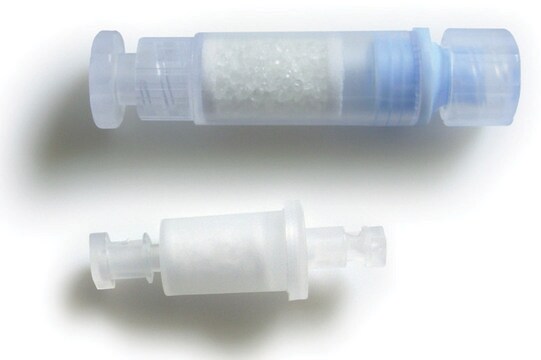おすすめの製品
使用法
kit sufficient for 12.5-25 mg process (lysate)
品質水準
メーカー/製品名
Calbiochem®
保管条件
do not freeze
保管温度
2-8°C
詳細
A rapid method for isolating ubiquitinated proteins using affinity beads comprised of a GST-fusion protein containing an ubiquitin-associated sequence bound to glutathione-agarose. Useful for the enrichment of polyubiquitinated proteins from cell and tissue lysates of a broad range of species including canine, human, mouse, and yeast. The ubiquitinated proteins can be identified by loading the beads directly onto SDS-PAGE and then immunoblotting with the antibody of choice or Anti-Ubiquitin (Cat. No. 662099). Alternatively, it is possible that the beads can be treated with Isopeptidase T (Cat. No. 419700) to release the proteins from the ubiquitin chains.
A vast majority of short-lived proteins are degraded by the ubiquitin-proteasome pathway. A protein marked for degradation is covalently attached to multiple molecules of ubiquitin, a highly conserved 76-amino acid (8.6 kDa) protein, by a multi-enzymatic system consisting of Ubiquitin-activating (E1), Ubiquitin-conjugating (E2), and the Ubiquitin-ligating (E3) enzymes. The E1 activates a Ubiquitin monomer at its C-terminal cysteine residue to a high-energy thiolester bond which is then transferred to a reactive cysteine residue of the E2 enzyme. The final transfer of ubiquitin to e-amino group of a reactive lysine residue of substrate proteins is brought about by the E3 enzyme. Ubiquitinated protein is then escorted to the 26S proteasome where it undergoes final degradation and the ubiquitin is released and recycled. A family of proteins including Rad23, contain two ubiquitin-associated domains that bind ubiquitinated cellular proteins and translocate them to the proteasome. Ubiquitinated proteins can be enriched using affinity beads comprised of a GST-fusion protein containing this ubiquitin-associated sequence conjugated to glutathione-agarose.
構成
Polyubiquitin Affinity Beads, Control Glutathione-Agarose Beads, Control Lysate, and a user protocol.
警告
Toxicity: Multiple Toxicity Values, refer to MSDS (O)
保管および安定性
Upon arrival store entire contents of the kit at 4°C.
その他情報
Chen, L. and Madura, K. 2002. Mol. Cell Biol. 22, 4902.
Chen, L., et al. 2001. EMBO Rep.2, 933.
Chen, L., et al. 2001. EMBO Rep.2, 933.
法的情報
Sold under license of PCT Application wo 03/049,602.
CALBIOCHEM is a registered trademark of Merck KGaA, Darmstadt, Germany
シグナルワード
Danger
危険有害性情報
危険有害性の分類
Acute Tox. 4 Dermal - Aquatic Chronic 3 - Eye Dam. 1 - Repr. 2 - Skin Sens. 1
保管分類コード
10 - Combustible liquids
適用法令
試験研究用途を考慮した関連法令を主に挙げております。化学物質以外については、一部の情報のみ提供しています。 製品を安全かつ合法的に使用することは、使用者の義務です。最新情報により修正される場合があります。WEBの反映には時間を要することがあるため、適宜SDSをご参照ください。
Jan Code
662200-PKIT:
662200-1KIT:
試験成績書(COA)
製品のロット番号・バッチ番号を入力して、試験成績書(COA) を検索できます。ロット番号・バッチ番号は、製品ラベルに「Lot」または「Batch」に続いて記載されています。
J Zhu et al.
Oncogene, 33(34), 4340-4351 (2014-01-21)
Estrogen receptor α (ERα) is initially expressed in the majority of breast cancers and promotes estrogen-dependent cancer progression by regulating the transcription of genes linked to cell proliferation. ERα status is of clinical importance, as ERα-positive breast cancers can be
Jian Chen et al.
The American journal of pathology, 175(1), 400-411 (2009-06-17)
Tumor hypoxia directly promotes genomic instability and facilitates cell survival, resulting in tumors with a more aggressive phenotype. The proto-oncogene pim-1 regulates apoptosis and the cell cycle by phosphorylating target proteins. Overexpression of Pim-1 can cause genomic instability and contribute
Christian Ehlting et al.
Scientific reports, 9(1), 11021-11021 (2019-08-01)
The p38MAPK downstream targets MAPKAP kinases (MK) 2 and 3 are critical for the regulation of the macrophage response to LPS. The extents to which these two kinases act cooperatively and distinctly in regulating LPS-induced inflammatory cytokine expression are still
Roi Cal et al.
Arteriosclerosis, thrombosis, and vascular biology, 33(2), 369-377 (2012-12-18)
Low density lipoprotein retention and aggregation in the arterial intima are key processes in atherogenesis. Aggregated LDL (agLDL) is taken up through low-density lipoprotein receptor-related protein 1 (LRP1) by human vascular smooth muscle cells (VSMC). AgLDL increases LRP1 expression, at
ライフサイエンス、有機合成、材料科学、クロマトグラフィー、分析など、あらゆる分野の研究に経験のあるメンバーがおります。.
製品に関するお問い合わせはこちら(テクニカルサービス)


